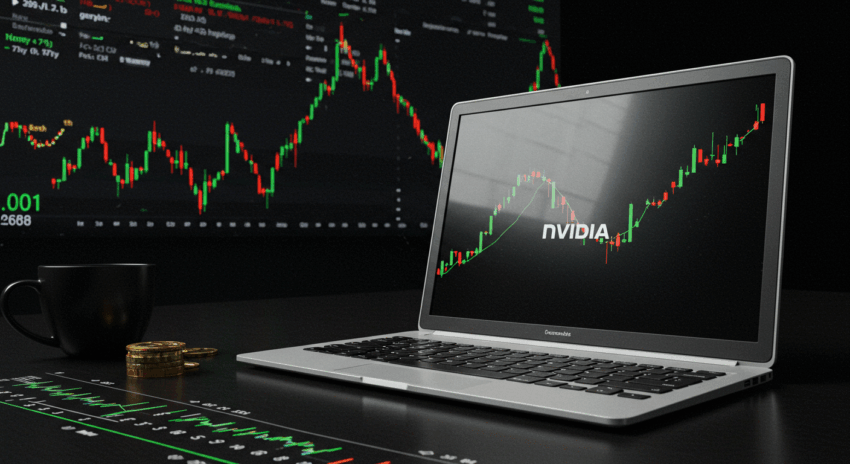The world of investment is buzzing with major news from the tech sector, and if you’ve been paying any attention to the markets, you’ve likely heard the name Nvidia. This giant in the world of computer chips and artificial intelligence has just made a significant move that has many investors talking: a 10-for-1 stock split. But what does that even mean? Is it a good thing? A bad thing? And most importantly, how does it affect you, the everyday investor?
Don’t worry, this isn’t nearly as complicated as it sounds. In this article, we’ll break down exactly what Nvidia’s stock split is, explain the mechanics behind it in simple terms, and explore why a company of this magnitude would make such a move. This is your guide to understanding one of the biggest financial headlines of the week.
Deconstructing the News: Nvidia’s 10-for-1 Split
Let’s get straight to the facts. Nvidia, a company whose stock price has soared to incredible heights (trading at over $1,200 per share recently), announced and has now completed a 10-for-1 stock split. The split took effect after the market closed on Friday, June 7, 2024, with shares beginning to trade at the new, split-adjusted price on Monday, June 10, 2024.
So, what does 10-for-1 mean in practice? It’s simple arithmetic:
- For every one share of Nvidia an investor owned, they now own ten shares.
- The price of each new share is roughly one-tenth of the pre-split price.
Imagine you owned a single share of Nvidia worth $1,200 before the split. After the split, you would own ten shares, and each of those shares would be worth approximately $120. The key takeaway here is that the total value of your holding remains the same at that moment: 1 share x $1,200 = $1,200, and 10 shares x $120 = $1,200. Your slice of the company pie is the same size; it has just been cut into more pieces.
What Exactly Is a Stock Split, and Why Bother?
A stock split is a corporate action where a company increases the number of its outstanding shares by issuing more shares to current shareholders. Simultaneously, the price per share is reduced proportionally, so the company’s total market capitalization remains unchanged. Market capitalization is simply the total value of all of a company’s shares (total shares multiplied by the price per share).
Think of it like a pizza. Imagine you have a large pizza that costs $20 and it’s cut into four large slices. A stock split is like telling the pizzeria to cut that same pizza into eight smaller slices instead. You still have the same amount of pizza, and it’s still worth $20 in total, but now the individual slices are more manageable and easier to share. In this analogy:
- The whole pizza is the company’s market capitalization.
- The number of slices is the number of shares.
- The cost per slice is the share price.
The total value of the pizza doesn’t change, but the format does.

The Psychology and Strategy Behind the Split
If a stock split doesn’t change the fundamental value of a company, why do it? The reasons are primarily psychological and strategic, aimed at increasing accessibility and liquidity.
1. Making Shares More Accessible to Retail Investors
This is the biggest reason. When a stock price climbs into the thousands of dollars, like Nvidia’s did, it can feel prohibitively expensive for the average person. While many brokerages now offer fractional shares (allowing you to buy a small piece of a share), there’s a powerful psychological barrier to a four-figure stock price. A lower price per share—say, around $120—feels much more attainable for an individual looking to invest a few hundred dollars. This can attract a whole new wave of retail investors, which is the term for individual, non-professional investors.
2. Increasing Liquidity
Liquidity refers to how easily an asset can be bought or sold without affecting its price. With more shares available at a lower price, trading activity often increases. More people buying and selling means the market for the stock is more fluid and active. This can lead to a tighter “bid-ask spread”—the difference between the highest price a buyer is willing to pay and the lowest price a seller is willing to accept—making trading more efficient.
3. Employee Stock Options
For a tech giant like Nvidia, a significant part of employee compensation comes in the form of stock options or grants. A lower share price makes it much easier and more flexible for the company to grant these awards to its employees, from senior engineers to new hires.
What This Means for Your Portfolio and Investment Strategy
So, we’ve established that a stock split is fundamentally a cosmetic change. If you are an Nvidia shareholder, the total value of your position did not change the moment the split occurred. However, the move can have secondary effects on your investment journey.
The increased accessibility and positive sentiment that often surround a stock split can sometimes lead to increased demand for the stock. This new demand could potentially drive the price up over time, though this is by no means guaranteed. History shows that for strong, growing companies, splits are often followed by continued long-term growth. However, a split cannot make a weak company strong.
Important Disclaimer: It is crucial to understand that a stock split, in and of itself, is not a valid reason to buy a stock. The decision to invest in any company should be based on its fundamental health: its revenue growth, profitability, competitive advantages, and future prospects. Nvidia’s split is happening because the company has performed exceptionally well, not the other way around. Always conduct your own research and consider your financial goals before making any investment decisions. This article does not constitute financial advice.
In conclusion, Nvidia’s 10-for-1 stock split is a headline-grabbing event that makes its high-flying stock more accessible to a broader range of investors. While it doesn’t alter the company’s intrinsic value, it’s a sign of confidence from a company at the forefront of the AI revolution. For investors, it’s a great opportunity to understand the mechanics of the market better and to remember that long-term success is built on a company’s performance, not its share price. To stay updated on more market-moving events, be sure to check our News section regularly.
Frequently Asked Questions (FAQ)
Does a stock split mean a company is a good investment?
Not necessarily on its own. A stock split is usually performed by companies that have seen their share price increase significantly, which is often a sign of strong performance. However, the split itself is a mechanical change. It doesn’t improve the company’s business or guarantee future success. You should always look at the company’s fundamentals—its financial health and growth prospects—before deciding to invest.
If I owned Nvidia stock, do I need to do anything to get my new shares?
No, you do not need to take any action. The process is handled automatically by your brokerage firm. If you owned one share before the split, your account will automatically be updated to show ten shares at the new, lower price shortly after the split’s effective date.



